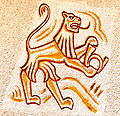Otto Bestereimer
Otto Bestereimer (born February 9, 1900 in Krems an der Donau , † December 29, 1967 in Klagenfurt ) was an Austrian painter and artist.
Life
The versatile artist was born in the Lower Austrian city of Krems. He was a student of Ferdinand Andri (1871–1956) at the Academy of Fine Arts in Vienna . On June 21, 1931 he married Luise Feiler, a Viennese Wagner singer. In the same year [1931] he chose Carinthia as his new home and settled in Klagenfurt. Bestereimer was also a member of the Schlaraffia men's association . An important motto of his was: "The bad should not rule the good!" He remained connected to his old homeland, so he was also a member of the Wachau Artists' Association . With painstaking work, he personally built his house at Konradweg 11 in the Sankt Martin district of Klagenfurt. He was busy with it all his life. From 1934 he became a member of the Carinthian Art Association . Bestereimer mainly painted landscapes in watercolor and oil , but he also dealt with glass painting . He also carried out metal driving work in Klagenfurt's public buildings (Chamber of Commerce, Concert Hall, Christkönigskirche, Dr. Karl Renner School, grave plaque for Primus Lessiak at the Sankt Martin Church). There were also works in sgraffito and fresco technique .
The academic painter died on December 29, 1967 from the effects of lung cancer in his house in Klagenfurt-Sankt Martin and was adopted at the Waldfriedhof in Villach .
From the Ute Krapf protocol
Bestereimer's only offspring is his daughter Ute Krapf. She literally characterizes her father: “A small, slender man with speaking dark eyes. Humorous, amiable, helpful in excess (he was seldom thanked), very sensitive, musical, seeing the positive in every situation, remained true to his ideals, a tireless worker to the point of exhaustion and the most caring, best father and grandfather that one could ever imagine can think. "
CV, presented by Ute Krapf
“My father had a very middle-class family. I do not know of any artistically gifted ancestors, apart from one of my father's grandfathers, who was music director of the Ragusa military band . That probably has nothing to say. His talent for drawing was already evident during his school days.
My mother is the daughter of the Viennese Ministerialrat Dr. Rudolf Feiler and his wife Luise geb. Wretschko. Wretschko's grandparents lived in Krems. So my parents knew each other when they were young. After finishing high school, my mother completed a vocal training course at the Academy in Vienna, but found no engagement in the poor economic situation of the post-war period . (Very good Wagner voice , hence her love for this music ⇒ see fresco on our house).
She was also a skilled craftsman, doing beautiful embroidery, and helping my father with all kinds of wall jobs. (For example, my father had to decorate a soldiers' home and a home for Norwegian children in Narvik as quickly as possible. He managed to get his wife to help him with the army command. So she was in Norway one summer during the war . )
These two people were a congenial couple, they stood by each other faithfully in many bad times.
How did my father come to Klagenfurt ?: One day his painter colleague Hermann Poschinger , whom he knew from Vienna, wrote him a funny card with a drawing. Got mine in the hamlet St. Martin a chaste built, come and visit me! . That was the beginning of the move to Carinthia . The landscape (he was mainly a landscape painter), the people and the southern light conquered my father's heart.
First orders: In Krems fresco at the city gate. Frescoes in a large public house. Restoration of frescoes in a Bohemian noble residence. War memorial in Lower Austria , etc.
In Carinthia, when the new seminary in Tarviserstraße was being built, he was commissioned by master builder Ing.Holey to make the entrance gate and the food grille of the new church. In addition, some small driving work in the church.
Lobisser and my parents knew each other very well.
And to Dermuth (hotel owner dynasty): Good neighborly relationship. See fresco above gate, Christophorus at the hotel, sgraffito at the rear building, menu, etc. "
Works (selection)
- Leaded glass window of the Church of Sankt Ulrich, west of Krastowitz Castle, Klagenfurt : Saint Bartholomew (designed in 1963).
- Fresco on the south wall of the Klagenfurt home on Konradweg 11 in Sankt Martin: “The three norns and the earth” (1932/33).
- Sgraffito on an east wall of the Klagenfurt home on Konradweg 11 in Sankt Martin: "Otto Bestereimer with wife Luise and daughter Ute".
- Grave plaque (metal drifting from sheet copper) on the north vestibule arch of the parish church of St. Martin in Klagenfurt.
swell
- Kärntner Landeszeitung on January 5, 1968
- People's newspaper on December 31, 1967
- Minutes of his daughter and estate administrator Ute Krapf
Individual evidence
- ^ Richard Milesi, Leopoldine Springschitz: Kärntner Kunst 1900-1970 , Künstlerhaus Klagenfurt, Kärntner Landesgalerie, Exhibition Board of Cultural Carinthia, 1970
- ↑ From the minutes of Ute Krapf, Bestereimer’s only daughter
- ^ Krug: Wachau, Pictures from the Land of Romanticism
Picture gallery
Web links
| personal data | |
|---|---|
| SURNAME | Best bucket, Otto |
| BRIEF DESCRIPTION | Austrian painter and artist |
| DATE OF BIRTH | February 9, 1900 |
| PLACE OF BIRTH | Krems at the Donau |
| DATE OF DEATH | December 29, 1967 |
| Place of death | Klagenfurt |




















